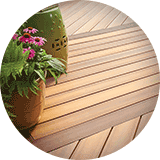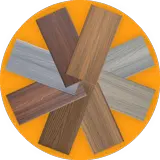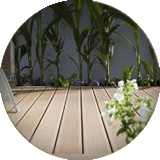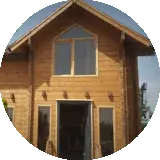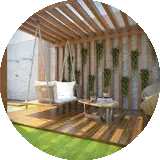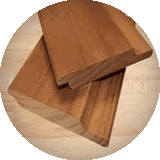Types of wood and their application
As you know, wood is used in many products today.Therefore, it is very important to know the types of wood and also their use and information about the price of wood.
It does not matter if we are a buyer of wood products or as a manufacturer of wooden products (such as a manufacturer of wooden doors), the more we know about wood and how to use it, the better and more affordable the purchase.
Be more economical. In Romak site, in the section of types of wood and their application, we will examine the characteristics of different woods, as well as the scientific name, dimensions and size of trees, characteristics and, most importantly, the price of wood.
To study the characteristics of woods also to know the daily price of woods (in terms of cubic meters), select your type of wood in the list below.
- Oak
- His wood
- Walnut wood
- Mulch wood
- Cherry wood
- Beech wood
- Honduran mahogany
- Russian wood
- Alder wood
- Teak wood
- Paulownia wood
- MDF wood
- Plaidwood
Wood price table in 1400:
The online price of Rooz Choob is presented in the table below, all prices are in Tomans and related to the date mentioned in front of it.
Type of wood Price in cubic meters (Tomans) Date
Dry yolk wood from 7.500.000 to 8.000.000 Tomans
Russian wood from 7,500,000 to 8,000,000 Tomans
Georgia beech wood from 10,500,000 to 12,000,000 Tomans
Turkish beech wood from 15.800.000 to 16.800.000 Tomans
American oak from 35,500,000 to 45,000,000 Tomans
Mulberry wood from 35,500,000 to 45,000,000 Tomans
Its wood from 35,500,000 to 45,000,000 Tomans
American walnut 68.000.000 Tomans 7 April 1400
Russian fir wood (low width) from 6,000,000 to 7,000,000 Tomans, April 27, 1400
Thermo wood from 420,000 to 850,000 Tomans
Other information about wood price table: As you know, wood price is variable and changes daily. Therefore, the above price table is updated daily. Another thing to note about prices is that there is not always a fixed rate for the price of each cubic meter of wood, so all rates are given in intervals.
As you can see in the list above; The price of beech wood varies in different types of Turks and Georgians. Beech wood has a relatively better quality, but both species are used in the woodworking industry.
Types of wood and their application
Thermo wood price
The price of thermo wood is based on one cubic meter. It should be noted that the price of thermowood floor wood is from 550,000 to 850,000 Tomans, while the price of thermo facade wood is from 420,000 to 650,000 Tomans.
Another point about the price of wood is your choice. Obviously, the price of timber is not equal to the price of slabs. Wood slabs are very practical and stylish for making counters and tables.
The most expensive tree wood
Ebony wood is the most expensive wood in the world. One kilogram of ebony wood is worth 10,000$.
The cheapest wood is pine and spruce. Yulka (Russian) wood is one of the most practical and cheapest woods in the wood industry.
The most expensive wood in Iran is Persian walnut. The wood of this tree is not mainly used for industry and carpentry.
Russian wood (pine)
name:
Pitch Pine (Common English Name)
Pirus Sibirica (scientific name of the tree)
Dimensions:
Pine tree height: from 20 to 35 meters
Pine tree diameter: maximum 1 meter
Specific weight:
Dry Russian wood has a specific gravity of 545 kg / m3.
Types of wood and their application
What is Russian wood?
Russian wood is a soft and light weight that is generally grown in the northern regions of the world. There are more than 100 different species of these trees around the world. The general features of this wood are its yellowish white color and smooth lines. In the following, we will introduce the characteristics of different types of Russian wood.
Other features of Russian wood:
In the wood market, any type of white wood imported from Russia is called Russian wood. While in the world, these woods have different names. Imported woods known as Russian include spruce, pine, yolk and sasna. Russian wood is widely used in the manufacture of all-wood doors and wooden windows. When buying Russian wood, make sure that the smaller the wood knot, the higher the quality of the wood.
Types of Russian wood:
In the Iranian market, Sasna and Yolka wood are known as Russian wood. It should be noted that Sasna wood has a lower quality than Yulka wood due to its many knots; For this reason, Sasna is used in the construction of wooden doors. Over time, it complicates and distorts the door, which unfortunately is not visible due to the hidden door.
Nrad, which is another species of Russian wood, is a pine tree that grows in mountainous areas. The color of this wood is generally white or cream-brown, but some species also have a reddish color. Fir wood has no gum ducts, straight and light, and due to its lightness and high elasticity, it is suitable for building structures. It is also widely used in the paper industry. One of the most important features of Nrad wood is its high resistance against wood-eating insects.
Application of Russian wood: In fact, Russian wood is always one of the most widely used woods in the door and furniture industry, to the extent that the best type of fireproof wooden door is made of 5 cm Russian wood and it is mostly used in Bao and Pasar doors. Moreover the low weight of this wood has made it one of the most widely used woods in furniture making. It is worth mentioning that the paintability of Russian wood is very high and in products that want the final color to be applied as a coating, the first priority is with Russian wood.
Types of wood and their application
Advantages and disadvantages of Russian wood:
Advantages of Russian wood: Due to the fact that it is a soft species, it has a reasonable price, lightweight and does not need to be hardened. In addition, it is relatively resistant to twisting and bending and has attractive designs for wood products.
Disadvantages of Russian wood:
It had knots and is vulnerable.
Allergy and poisoning of Russian wood:
Working with Russian wood over time can cause skin allergies for some people.
Types of wood and their uses
The importance of using Russian wood in industry
Considering that a large area of forests and trees are destroyed every year in order to supply wood; Russian wood is considered by many manufacturers of wood industry. In fact, using Russian wood to produce wood products is a big step towards protecting the environment.
Pine trees grow faster and reproduce faster than other species, including oak, so they are considered renewable pine forests. Yellow pine wood, which is more compact, is used in the construction industry where as white pine, which is considered softer, is used in carpentry.
Types of wood and their application
Red and white oak
name:
Oak (Common English Name)
Quercus (scientific name of the dark tree in English)
Dimensions:
Height of red oak tree: 25 to 35 meters
White oak tree height: 20 to 25 meters
Red oak tree diameter: 1 to 2 meters
White oak tree diameter: 1 to 1.2 meters
Specific weight of red oak: 700 kg per cubic meter
Specific weight of white (yellow) oak: 755 kg / m3
Types of oak:
Red oak: They are known as American and Canadian oak and have wavy veins, so that their veins are more wavy than Iranian oak. Red oak varies from dark pink to brown.
Persian oak: Persian oak is more straight than western examples
Black Oak: This oak is found in California, USA
White oak: This oak grows mostly in Spain and Illinois.
Other features of oak:
Oak wood is compact and strong , it is a symbol of strength and endurance. In the past, it was considered ad one of the most important building materials in Eastern Europe. In addition to using this type of wood in the construction industry, it is also used in doors and interior decoration. Shipbuilding was also used. Oak is a heavy wood and one of the hardest woods. The strength and beauty of oak makes this wood ideal for making all kinds of cabinets, furniture and flooring materials. The open pores of oak make it easily stainable, which causes changes in its color.
One of the unique features of oak wood is its rough surface (rough, full of patterns and indentations) which makes it easily recognizable and only by looking and touching the wood we realize that this wood is related to an oak tree.
What are the reasons for the popularity of oak?
Perhaps the most important reason for the popularity of oak is the comfortable growing of this tree in different climates, so this wood is available in many places,on the other hand, its high strength has made it as one of the most popular and widely used woods.
Allergies and poisoning:
When working with oak, be sure to take special care because oak is one of the woods that is allergenic. This type of allergy causes symptoms such as itchy eyes and skin.
Beech wood
name:
Beech (Common English name)
Fagus (Dark Tree Name)
Dimensions:
Beech height: 30 to 40 meters
Beech tree diameter: 1 to 1.5 meters
Specific weight: 710 kg / m3 (European dry beech wood)
Other features of beech wood:
Beech wood is from the category of broad-leaved wood (with many leaves) and the color of the beech wood (inside) is reddish cream. it is a semi-heavy wood and has a homogeneous texture which is resistant to insects and fungi. wood is also used in door and window making, furniture making, railway sleepers, tables and chairs and considered one of the most widely used wood species in the carpentry industry.
What is beech wood?
Beech wood is straight, has high parallel and compact fibers, high strength and reasonable price. Beech has very beautiful natural patterns, so it is also used as a veneer (laminate cuts). This wood does not fall into the category of aromatic woods. But this does not mean that the wood does not smell like wood.
The number of beech tree species is numerous and is more than 650 species. Beech tree species are divided into 7 categories in terms of genus; 3 species of beech tree in Iran, 11 species in the northern hemisphere and one species known as eastern beech grow in the northeastern part of Turkey, the Caucasus and the Alborz mountain range. The most famous beeches are German beech and American beech.
Iranian beech: This tree is generally grown in sunny and northern regions of Iran. In fact, the beech tree is resistant to cold. The wood of this tree is very beautiful because of its fine texture and light color. This wood has good resistance to damage. Also, the color of this wood is good.
Click here to see the door made of beech wood.
Allergies and poisoning:
Working with a rash for a long time can cause skin allergies.
Beech wood prices:
Beech, like other wood families, has different prices depending on the species and country of origin. For example, the price of Georgian beech wood is lower than Turkish beech.
Interesting facts about beech trees
Numerous species of beech grow in Europe, Asia and North America. Acidic and alkaline soils are suitable for growing beech trees, but it is better to use gypsum and calcareous soils.
beech tree generally has a relatively short trunk and the crown of the tree (foliage) is wide and broad. lifespan of beech trees is from 150 to 400 years and their height is from 15 to 150 meters, which depends on the species of the tree.
bark of the tree has a soft surface and its color is light gray. Beech leaves are toothed and their height is from 5 to 15 cm and their width is 4 to10 cm. Fresh leaves are light green and the surface is covered with down, while old leaves are darker in color and lack lint.
It is interesting to know that in modern Germany the word Buch is used for the word book and Buche also means beech tree.
Types of wood and their application
Malch wood
name:
ELM (Common English Name)
Ulmus Glabra (common scientific name of the family)
Dimensions:
Melch tree height: 25 to 35 meters
Melch tree diameter: 1 to 1.5 meters
Specific weight: Dry melch wood is 575 kg / m3
Other features of melch wood:
This wood is one of the beautiful and well-patterned woods that is considered as a broad-leaved and hard wood, this type of wood has a reddish brown color in which sometimes green veins can be seen. Mulch wood is used in making polywood, boats, furniture, and Carpenter
Alder wood
name:
Alder (Common English name)
Alnus (scientific name of the tree family)
Glutionose Alnus (Summer alder)
Subcordate Alnus
Dimensions:
Height of alder tree: 20 to 25 meters
Alder tree diameter: maximum 0.6 m
Specific weight of alder tree: Dry alder wood 495 kg / m3
Other features of alder wood:
The alder tree is broad-leaved and has more than 30 different species in the world. This wood tree is similar to beech wood, but the color of alder species is lighter than beech and its texture is slightly different. Beech also weighs more than alder.
The alder tree absorbs a lot of water and grows in humid areas. For example, in the northern regions of Iran such as Mazandaran, Gorgan, Gilan, Astara, Talesh and Taleghan this plant grows. The life of this tree is about 100 years and its growth stops at the age of 50.
Alder has a soft wood and turns white when cut, but after a while it turns light pink. This wood is easy to work with, has good paintability and is water resistant. The disadvantage of this wood is its low durability. Summer and Qashqai species are among the alder trees that grow in Iran.
Alder wood is used for woodcarving, veneering, boat building and other wood industries.
Allergies and poisoning:
Continuous work with alder causes itchy eyes and skin as well as respiratory problems.
Alder wood prices:
Contact for information on the price of alder wood (in cubic meters)
Types of wood and their uses
Walnut wood
name:
European Walnut (Common English Name)
Juglans Regia (scientific name)
Dimensions:
Walnut tree height: 24 to 35 meters
Walnut tree diameter: 1.5 to 2 meters
Specific weight of walnut tree: European walnut dry wood 640 kg per cubic meter
Other features of walnut wood:
The color of this hard wood can be from light pink to dark chocolate, and the pattern of walnut wood consists of rings, straight veins and knots. Walnut tree, which is considered as a broad-leaved tree, was first in Iran and some Asian countries, until now, with the transfer of its seedlings from Iran to Europe and the United States, it is now cultivated in these countries as well. Walnut wood growth rings indicate the age of the tree.
Other features of walnut wood:
Walnut tree has a very high economic value, that is why imported walnut species are used in Iran.
The hardness of walnut wood is not very high. Due to the very beautiful pattern and radiance of this wood, walnut is one of the most beautiful and expensive species. Walnut tree is used in the production of furniture, cabinets, doors, gun handles, musical instruments, upholstery and wooden objects.
Allergies and poisoning:
Constantly working with walnuts can cause skin allergies.
Walnut wood prices:
Contact us for the price of American walnut wood (in cubic meters)
For information on the price of Canadian walnut wood (in cubic meters) and the price of walnut wood sheet, contact us
It should be noted that these prices are based on each cubic meter, as a result, for information on the price of each ton of walnut wood, please contact the sellers and buyers of wood directly.
Types of wood and their uses
American walnut wood
Walnut, also known as black walnut wood, is one of the hardwoods that grows in the eastern parts of North America. The inner texture of walnut is golden to chocolate and has dark streaks that are purple-brown. Trees that are exposed to sunlight have a lighter inner texture.
American walnut wood with its attractive appearance and high durability is used in the woodworking industry.
His wood is white
name:
White Ash (Common name)
Fraxinus Americana (scientific name)
Dimensions:
Tree height: from 20 to 30 meters
The diameter of its tree: one and a half meters
Specific weight of the tree: Its dry white wood is 675 kg per cubic meter
Other features of white wood:
It is one of the hardest woods among the trees. Its wood color is light brown American and has oak-like veins and roots. The veins and roots are smooth, regular, and in some cases curved. American is used as flooring, wooden boxes, barrels, basketball hoops and wooden handles. Its tree is planted in Turkey, Europe and America.
Price of white wood:
Contact us to know the price of his wood (in cubic meters)
Types of wood and their uses
Honduran mahogany
name:
Honduran Mahogany (Common Name)
Swietenia Macrophylla (scientific name)
Dimensions:
Mahogany height: 46 to 60 meters
Mahogany diameter: one to two meters
Other features of Honduran mahogany:
The color of mahogany varies from light brown to reddish brown. The roots and veins of this tree can be smooth, interconnected, irregular or wavy. Common use of this wood in making furniture, cabinets; used for veneers, wooden doors, and musical instruments.
Honduras mahogany prices:
Contact us for the price of mahogany (in cubic meters)
Types of wood and their uses
Cherry wood
name:
Sweet cherry (Common name)
Prunus avium (scientific name)
Dimensions:
Cherry tree height: 10 to 20 meters
Cherry tree diameter: about half a meter
Specific weight of cherry tree: Dry cherry wood 600 kg per cubic meter
Other features of cherry wood:
color of the cherry wood is pale pink when freshly cut and then turns golden and brown. veins of this wood can be straight or wavy. use of cherry tree is used in the industry of veneer, furniture, cabinet making, musical instruments and woodcarving.
Allergies and poisoning:
No physical problem has been reported from working with cherry wood, but in some cases it is accompanied by itching and slight burning.
Cherry wood price:
Contact us for the price of American cherries (in cubic meters)
Types of wood and their uses
Teak wood
name:
Teak (Common name)
Tectona Grandis (scientific name)
Dimensions:
Teak tree height: 30 to 40 meters
Tea tree diameter: 1 to 1.5 meters
Specific weight: Dry teak wood 655 kg per cubic meter
Other features of teak wood:
Teak is a hardwood and deciduous tree that grows mostly in India, Sri Lanka, Indonesia, Malaysia, Thailand, Myanmar and Bangladesh in South and Southeast Asia.
(Used in prefabricated wooden houses)
Allergies and poisoning:
Working with teak wood causes skin allergies
Types of wood and their uses
Paulownia wood
name:
Paulownia (scientific name)
Features of Paulownia tree:
Paulownia tree is one of the fastest growing species and generally grows in South Asia. Due to its deep and resilient roots, this tree is resistant to wind and storms. It is interesting to know that Paulownia tree grows even in areas that do not have good soil. As a result, it is a suitable species for afforestation. Cultivation of this tree is also common in Europe and America today.
Features of Paulownia wood:
Paulownia wood is one of the hard and light woods that is very useful in the woodworking and construction industries. Paulownia has no knots, so it is of high quality. It can be said that the weight of this wood is one third of the weight of oak wood. This wood also has high resistance and needs good resistance against insects.
MDF wood
name:
Medium-Density-Fibreboard stands for MDF
Dimensions:
As you know, MDF wood is a wood product and is produced in the form of sheets, and basically these sheets have the following dimensions:
1. 1830X4100 mm
2. 1830X3660 mm
3. 1830X2440 mm
4. 1220X2440 mm
These sheets have thicknesses of 3-4-6-8-10-12-14-16-18-20-25-35 mm.
Other features: MDF wood:
MDF wood is actually a wood product and is a kind of fiberboard, this is the biggest difference between MDF and other woods mentioned in this article because the above woods are produced directly from nature and without human intervention ,unlike MDF, which is man-made and has no external existence in nature.
MDF wood has a density of 650 to 800 kg per cubic meter. In fact, density is one of the most important factors in determining the quality of MDF wood, that is, the higher the density of wood, it means that MDF has a better quality. After production, MDF can be covered with (natural) wood, which has led to variety and beauty in it.
One of the best MDFs in the MDF market in Thailand is Wanchai (refer to www.vanachai.com to get acquainted with this company). Perhaps the most important difference between Iranian MDF and Vanachay is that the density of Vanachai MDF is higher. This makes the wood wave much less after painting, so the final quality of products made with MDC. The external F is much higher. Of course, some Iranian MDFs are made from sugarcane stalks, which are not of good quality, but today we are witnessing the production of quality Iranian MDFs in Iran, which are also reasonably priced.
Price of MDF wood:
For information on the price of teak wood (in cubic meters), click on the price of MDF wood.
Polywood is a layer of wood that is pressed together as a warp under high pressure and temperature. It should be noted that Russia and Malaysia are the main producers of polywood and the most important point about polywood is this. Unlike the Malaysian brand, the Russian brand is waterproof, which usually uses Russian polywood in places where the wood is exposed to moisture.
The number of layers worked in individual wood polywood is about 5, 6 or 15 mm thick. In the photo below, Plaid Wood has seven layers.
The difference between polywood and MDF for making wooden furniture?
Many manufacturers and designers of wood products prefer plaidwood to MDF for two reasons:
1. Is it easier to use polywood to make wooden products?
Polywood holds the screws in place. This allows them to attach well to other objects. In fact, polywood is very strong, so you can screw the wood without damaging it. Put it inside. But MDF is very sensitive and it is difficult to put screws in it without damage. When you insert the screws into the MDF, the screw splits the fibers and in many cases causes the fibers to separate or completely slit. For this reason, many manufacturers believe that a guide hole should be drilled before inserting the screws into the MDF with a drill inside it. This ensures that the screws never come into direct contact with the MDF.
Polywood can be cut or sanded anywhere, but MDF can not be cut or sanded in places where there is no proper air circulation. When working with MDF, wood dust will spread in the air, it should be noted that MDF wood soil is much more harmful than ordinary dust because its surface is covered with a toxic chemical called formaldehyde. According to doctors, MDF soil is so dangerous that it should not be treated at all if possible.
2. Polywood is more portable.
Polywood is lighter than MDF. Imagine you are working with a 4.8 cm wood that is three quarters of an inch (1.905 cm) thick. If this wood is made of light polywood, it will weigh about 27 kg. If this wood is made of MDF, it will weigh 45 kg.
Sell wood
The sale of various types of wood, including oak, beech, walnut, Sasna, Yolka, is done by a large number of sellers and importers of wood in our beloved country.
Types of wood and their application



